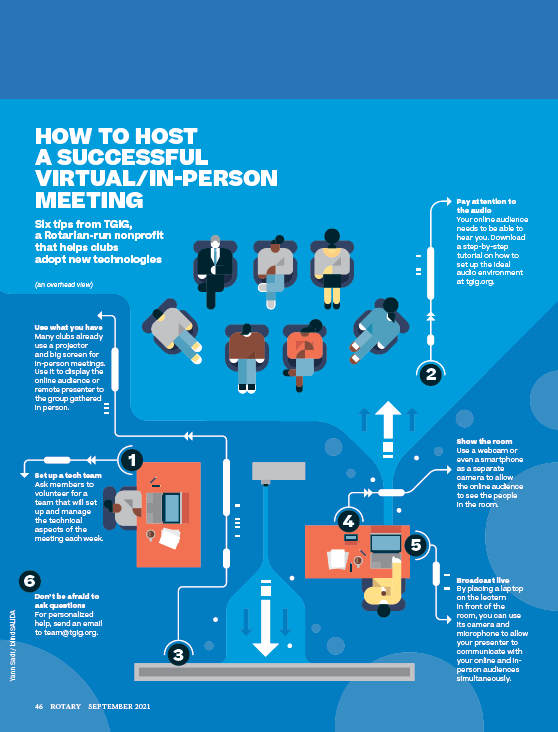
In April, the Washington Post published an article titled “What We’ll Keep.” Eleven writers looked at aspects of life during the pandemic that they’d like to see continue, such as the flexibility to telecommute, a deeper appreciation for essential workers, and more time spent in nature.
Staying home to slow the spread of COVID-19 disrupted our daily routines — but it changed some things for the better. Now we’re at a collective crossroads. As society reopens, how can we use what we’ve learned to make our lives better? How do we improve upon what we used to accept as “normal”?
When Rotary surveyed its members at the end of 2020, 75 percent of Rotarians reported that their clubs were mainly meeting online during the pandemic, while 18 percent were mostly meeting in person. A small number of clubs had stopped meeting altogether.
But even though the majority of clubs successfully adapted to virtual meetings, Zoom repeatedly was mentioned as a source of fatigue and frustration, especially among a segment of surveyed members who had belonged to Rotary for seven years or more. Some newer members, however, weren’t as bothered by the switch. One who has embraced it is Jenny Stotts.
Stotts helped charter the Rotary Club of Athens Sunrise, Ohio, in 2016. The club met in a coffee shop until the pandemic shut down in-person meetings. They then shifted to Zoom, which became helpful to Stotts when the club’s 7 a.m. meetings began to conflict with her kids’ schedules. She appreciated the opportunity to multitask, dialing in to the virtual meeting while driving her children to school. That’s the kind of flexibility she hopes the club will continue to offer.
“When I hear that we’re ‘going back,’ I gently say, ‘No, we’re doing what’s next,’” Stotts says. “I know people are really Zoom fatigued. But it’s not Zoom that’s bad. It’s all the time people have been spending on it that wears you out.”
“Videoconferencing is here to stay,” predicts Jeremy Bailenson, director of Stanford University’s Virtual Human Interaction Lab — not only for organizations like Rotary but for workplaces as well. “Zoom has the potential to continue to drive productivity and reduce carbon emissions by replacing the commute,” he wrote in the journal Technology, Mind, and Behavior in February.
It also saves money, a factor the corporate world has seized upon. In 2020, Mark Zuckerberg predicted that over the next five to 10 years, half of Facebook’s workforce could be remote. Google offers a hybrid work model that encourages staff to come into the office three days per week for collaboration and allows most employees the freedom to work remotely the other two.
Stotts, who serves as District 6690 membership chair, hopes that Rotary clubs also continue to take advantage of videoconferencing — not just to offer flexibility to current members but also to engage new ones. “It’s part of that bigger inclusion message,” she says. “It’s time to ask: Who’s missing from this club and why? Maybe virtual makes sense for them. This is the ideal time to focus on giving people more ways to join.”
Crisis brings opportunity
Last September, Anthony Fauci, director of the National Institute of Allergy and Infectious Diseases, took time away from advising the U.S. government on its pandemic response in order to speak virtually at a Rotary club meeting held inside a garage. (Yes, a garage.)
The meeting was at the home of Jim Marggraff, a member of the Rotary Club of Lamorinda Sunrise, California, and the setup — though simple — was well-ventilated and allowed those who chose to attend in person enough room for social distancing. “With Zoom meetings came the opportunity for resourceful clubs to recruit world-renowned speakers,” Marggraff says. Because Fauci was able to present via video, the club’s meeting location was not a limiting factor. Other presenters at the meeting included then-RI President Holger Knaack as well as leaders from the Bill & Melinda Gates Foundation and the World Health Organization.
Marggraff recorded the meeting — including the in-person aspects — so he could share how the concept works; he also put together a tutorial to help other clubs hold their own hybrid meetings. “The idea was to produce a video to help clubs see how easy it can be to host a hybrid or virtual/in-person meeting — one that brings people together physically while giving remote members simultaneous access to the meeting,” Marggraff says. (View the garage meeting and the tutorial at tgig.org.)
Marggraff, an inventor and entrepreneur, is best known for creating LeapFrog’s popular LeapPad system, which helps children develop reading and math skills. Now he’s focusing on helping Rotary clubs through a nonprofit he founded, The Global Impact Group (TGIG), which is run by Rotary members and aims to help nonprofits make better use of technology.
The expanded accessibility provided by virtual meetings is a perk for members who, in the tradition of attending make-up meetings while away from home, simply want to visit different clubs, as well as for members who might not be able to attend inperson meetings because of health concerns or time conflicts. Jim Simmermon is one Rotarian who has taken full advantage of the options opened up by virtual meetings.
Simmermon, who is 95 and lives in a retirement home in Pennsylvania, attends his regular Tuesday meeting of the Rotary Club of Oakmont Verona, Pennsylvania, via Zoom. Then on Wednesdays, he joins the online meeting of another club where he used to be a member, and every Thursday he attends another online meeting, this time of his son’s Rotary Club of Highlands Ranch (Littleton), Colorado. “I like attending Rotary meetings; it gives me a lift,” Simmermon says. “It doesn’t matter how old you are. Anyone can do Zoom.”
Scott Doll, who serves as CEO of TGIG, predicts that in the wake of the “Zoom boom,” new technologies will make it easier to add a virtual component to any meeting. “Face-to-face contact will always be desirable,” says Doll, a member of the Rotary Club of Alpharetta, Georgia. “But I also think we’re going to see advances in virtual meetings and hybrid tech that will make it far more user-friendly and accepted as one of the primary ways we meet” — be it for business, pleasure, or civic good.
Meeting the challenge
“We have to use three to four different internet connections to hold a hybrid club meeting, in case one goes down,” says Diehdra Potter, a member of the Rotary Club of Road Town, British Virgin Islands, which started holding blended virtual/in-person meetings in summer 2020. “We had members who really wanted the normalcy of being with fellow Rotarians,” Potter says. “But those in the at-risk group were not comfortable meeting in person.”
Potter, the club’s 2020-21 administrative director, says that even though she doesn’t consider herself particularly tech-savvy, she was determined to figure out a way to make meetings work for everyone. But with an unreliable internet connection at their outdoor meeting space — the patio of a restaurant — the new system took a while to perfect.
“At one of our sessions, our district governor said only three words before the internet went down and he was frozen,” Potter recalls. “We had to wait a few minutes and reset. But before you knew it, he cracked a joke and continued.” Since then, Potter has learned to utilize the venue’s two Wi-Fi networks as well as other connections, such as mobile hotspots, in order to manage the multiple laptops and phones required to film the in-person attendees and project the Zoom participants. The other available internet connections serve as backups.
Potter’s persistence has paid off: Overall attendance of club meetings is up by 35 percent. “We have additional members at home who log on,” she says. “Sometimes we’ll have 40 members from our club and 20 from other clubs — that includes Rotaract and Interact.” Many of those who attend virtually are on other Caribbean islands.
“When our borders closed to tourists, many of our members experienced losses in their businesses,” Potter says. “They had to shut down, or lay off staff. Without revenue, many were worried.” That’s one of the reasons Potter felt compelled to keep the club going. “We needed these meetings to take care of ourselves,” she says. Elvis Harrigan, a Road Town member, echoes that sentiment. “Since 2017, we’ve had multiple hurricanes, then COVID-19, and now a volcanic eruption on St. Vincent,” Harrigan says. “Through all of this, Rotary has been a source of stress relief.”
“Hybrid meetings may require a lot of planning, but it’s worth it because you have to reach people where they are,” Potter adds. “In difficult times, we can find joy in something we love — which is Rotary.”
What’s next
“People are changing, and priorities are getting reshuffled,” says Tom Thorfinnson, a member of the Rotary Club of Eden Prairie Noon, Minnesota, and Rotary International’s chief strategic officer. As people emerge from a year or more of isolation hoping to be more purposeful with how they spend their time, Thorfinnson believes that clubs have an opportunity to lean in to Rotary’s core values of providing meaningful service opportunities and building relationships.
While most Rotarians reported that the COVID-19 pandemic has not affected their likelihood of remaining a member in the next year, about 9 percent of those surveyed said that it is less or much less likely that they will remain a member.
While Zoom fatigue has played a role for some, so has the cost and time associated with being a member. That’s where keeping a virtual option could help clubs maintain their membership.
“It cuts down on expenses to the member if you meet virtually twice a month and in person twice a month,” says Jeffry Cadorette, a past RI director who chaired a task force that evaluated how Rotary clubs and districts might best take advantage of virtual connectivity in the future. A hybrid club with a virtual option doesn’t have to be technologically complicated, he notes, and it could offer a more flexible alternative for members concerned about the cost and time it takes to commit to Rotary.
“Our traditional club models got us through our first 115 years,” Cadorette says. “But we are not going to be relevant a decade from now if we only depend on our breakfast, lunch, and dinner clubs. We need to honor our past but retool for the future.”
